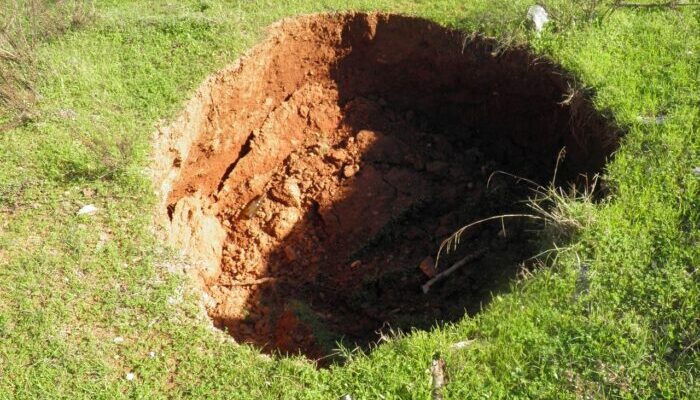
On August 23, 2024, a tragic event unfolded in Kuala Lumpur, Malaysia, when an 8-metre-deep sinkhole opened up on Jalan Masjid India, swallowing Vijayalakshmi Gali, a 48-year-old woman visiting from India [1]. The incident has raised serious concerns about public safety and the integrity of urban infrastructure.
A sinkhole is a natural depression or hole that occurs in the ground when the surface layer collapses. This can happen due to the dissolution of soluble rocks, like limestone and water, which gradually erodes the underlying materials. Anthropogenic activities such as drilling or mining can also cause sinkholes. They can vary in size and often appear suddenly, posing significant risks to structures and human safety. Sinkholes are most common in areas with karst topography, where the underlying rock is prone to erosion by water.
The 2024 Kuala Lumpur sinkhole was a consequence of rapid urban development, poor drainage designs and unstable soil conditions. Kuala Lumpur, like many fast-growing cities, has experienced pressure on its infrastructure due to expansion, with increased construction sometimes exacerbating natural vulnerabilities. Over time, excessive water erosion and subsurface instability created conditions ripe for a sinkhole to form. This incident serves as a crucial reminder of the importance of effective urban infrastructure management and public safety [2]. The tragic event highlights several key lessons that cities must apply to prevent similar scenarios in the future.
The necessity for regular infrastructure inspections cannot be overstated [3]. Routine evaluations of underground utilities, including sewage systems and water pipes, are vital for identifying vulnerabilities before they escalate into significant failures. By implementing a proactive maintenance culture, municipalities can identify potential risks early, averting hazardous incidents like sinkholes.
Understanding the geo-environmental characteristics of an area is equally essential [4]. This includes assessing soil types, underlying geological structures, and underground water flow patterns. Knowledge of these factors allows city planners and engineers to make informed decisions about construction and land use, particularly in regions prone to sinkhole formation. Comprehensive geological assessments can significantly enhance risk management strategies.
Moreover, developing comprehensive emergency response plans is crucial [5]. These plans should include specific protocols tailored to sinkholes and similar geological events. A well-prepared response can greatly improve the effectiveness of rescue operations, ensuring that first responders have clear guidelines to follow in emergencies. This preparation not only decreases response times but also minimises confusion and chaos during crises.
Effective communication is an essential component of disaster risk management [5]. Clear communication about potential risks and safety measures can help reduce panic and keep residents informed during emergencies. By providing timely updates and guidance, authorities can foster a sense of community trust and resilience, encouraging residents to stay vigilant and report any concerns. For instance, a centralised emergency notification system can be established to inform residents in real time about crises, offering clear guidance on what actions to take.
Investing in advanced mapping technologies is another critical step for urban safety [6]. Detailed maps of underground utilities are indispensable for urban planning and emergency response. Accurate mapping allows for more efficient inspections and helps first responders navigate hazardous areas during emergencies, significantly enhancing safety for both the public and rescue teams. This includes city planners investing in Geographic Information Systems (GIS) to develop digital infrastructure maps, which are accessible to emergency services and urban planners.

Kuala Lumpur City, Malaysia (Image credit: Polina Kuzovkova, Unsplash licence)
Furthermore, fostering collaboration among various governmental and non-governmental agencies can improve rescue operations and infrastructure management [7]. A coordinated approach ensures that resources are effectively utilised and all stakeholders work towards a common goal. Collaborative efforts can facilitate information sharing, leading to better preparedness and response strategies. For example, a task force of representatives from public safety departments, local non-profits, healthcare providers, and utility companies can be established. Such a task force could coordinate resources and actions during hazards.
Engaging with local communities is vital for raising awareness about hazards and encouraging the reporting of issues [8]. Community involvement plays a crucial role in identifying potential risks that may go unnoticed by authorities. By empowering residents to participate in safety initiatives, cities can create a more resilient environment where everyone is vigilant and informed. The idea of community involvement can be deepened by organising monthly community meetings where residents can raise concerns about infrastructure safety (e.g., cracked roads, sinkholes), which can then be addressed by local authorities in a timely manner.
Legislative action is necessary to review and update regulations related to construction and infrastructure maintenance [9]. Stronger regulations can help ensure that safety standards are upheld, minimising the risks associated with sinkholes and other geological hazards. Authorities should prioritise the implementation of regulations that mandate thorough risk assessments before any construction projects commence.
Lastly, supporting research and development into sinkhole prevention and mitigation strategies is essential for fostering innovative safety solutions [10]. Ongoing research can lead to developing new technologies and methods for identifying and addressing potential risks. By staying at the forefront of scientific advancements, cities can better prepare for and respond to geological hazards. This includes implementing legislation requiring all new construction projects to undergo environmental and safety risk assessments before approval.
In conclusion, the 2024 Kuala Lumpur sinkhole serves as a stark reminder of the vulnerabilities fast-growing cities face when infrastructure, planning, and environmental considerations are not prioritised. To prevent similar disasters, urban centres must adopt a proactive, multi-faceted approach that emphasises regular inspections, advanced technologies, informed legislation, and community engagement. Effective collaboration between governments, engineers, emergency services, and residents is key to fostering safer, more resilient urban environments. By applying the lessons learned from this tragedy, cities can better prepare for future challenges, ensuring public safety and sustainable development for generations to come.
References
[1] Singh, Namita (27 August 2024). “Search continues for missing woman who vanished into 8-metre sinkhole in Kuala Lumpur”. The Independent. Retrieved 29th September 2024
[2] Bedi, Rashvinjeet Singh (26 August 2024). “Malaysia searching manholes, sewage plant again for sinkhole victim as mayor declares Kuala Lumpur ‘safe'”. CNA. Retrieved 29th September 2024.
[3] Paz, S. V. L., Limos-Galay, J. A., & Lazaro, N. J. (2024). Disaster mitigation strategies and preparedness of personnel of the municipality of Bulalacao: Basis for disaster management safety plan. International Journal of Research Studies in Educational Technology, 8(2), 117-130.
[4] Martins, B., Catarina P., Adélia Nunes, A. B., & Carlos, H. (2024). Geo-Environmental Factors Controlling Gully Distribution at the Local Scale in a Mediterranean Environment. CATENA 236: 107712.
[5] Prasetyo, A., Sumarno, S., Jayaputra, A., Benedictus, M., Murni, R., Nainggolan, T., Wibowo, A. M. (2024). Critical communication of disaster preparedness areas for informational strategies in disaster management in Indonesia. Progress in Disaster Science, 24, 100368.
[6] Peixoto, J. P. J., Bittencourt, J. C. N., Jesus, T. C., Costa, D. G., Portugal, P., & Vasques, F. (2024). Exploiting geospatial data of connectivity and urban infrastructure for efficient positioning of emergency detection units in smart cities. Computers, Environment and Urban Systems, 107, 102054.
[7] Amin, M. (2023). Role of non-governmental organizations (NGOs) in Disaster Response and Recovery Efforts: An Investigation in Bangladesh. ASEAN Journal of Community Service and Education, 3(1), 57-68.
[8] Fazeli, S., Haghani, M., Mojtahedi, M., & Rashidi, T. H. (2024). The role of individual preparedness and behavioural training in natural hazards: A scoping review. International Journal of Disaster Risk Reduction, 105, 104379.
[9] Hauashdh, A., Nagapan, S., Jailani, J., & Gamil, Y. (2024). An integrated framework for sustainable and efficient building maintenance operations aligning with climate change, SDGs, and emerging technology. Results in Engineering, 21, 101822.
[10] Zhang, Y., Jiao, Y.-Y., He, L.-L., Tan, F., Zhu, H.-M., Wei, H.-L., & Zhang, Q.-B. (2024). Susceptibility mapping and risk assessment of urban sinkholes based on grey system theory. Tunnelling and Underground Space Technology, 152, 105893.
Post edited by Hedieh Soltanpour and Soheil Mohammadi




